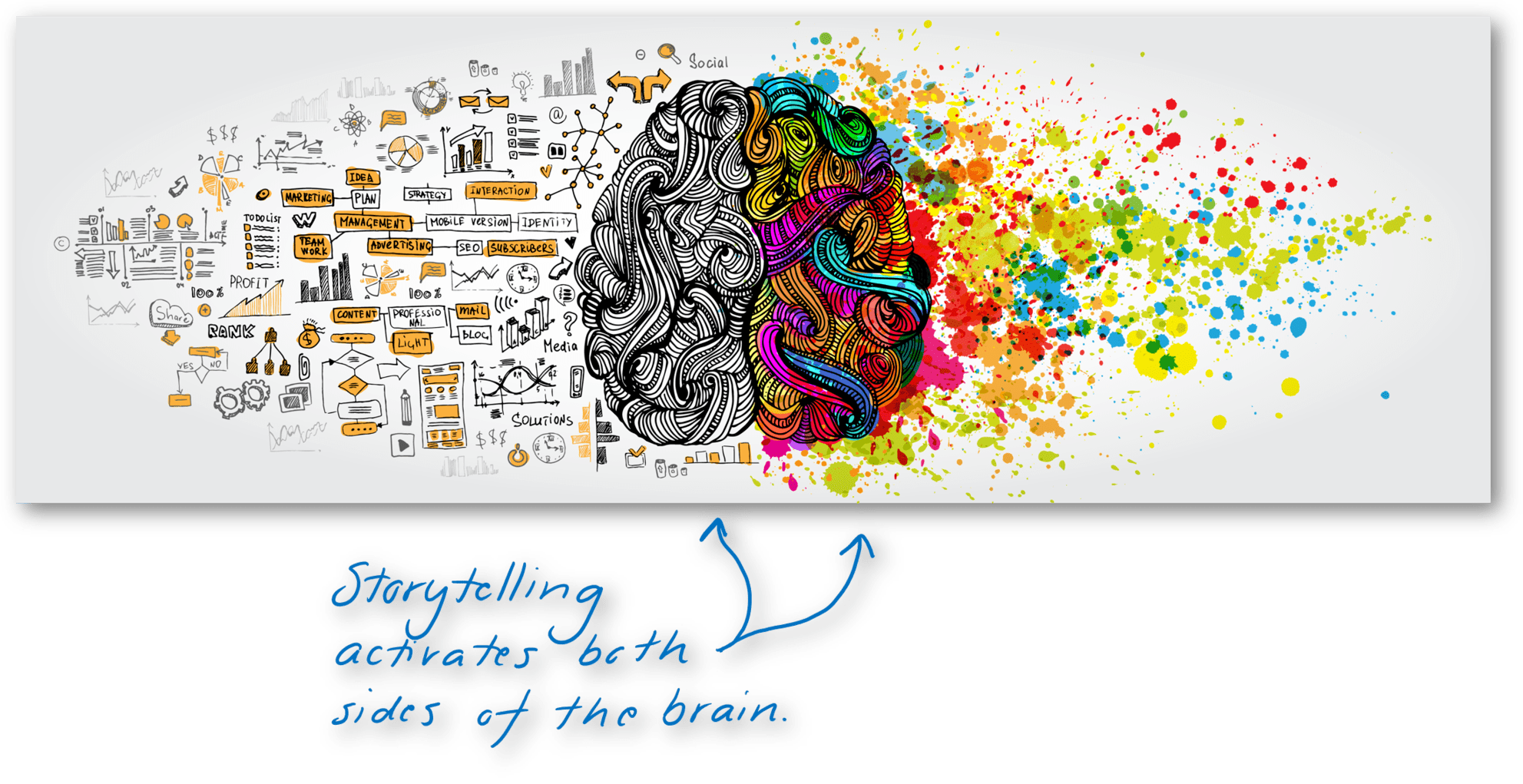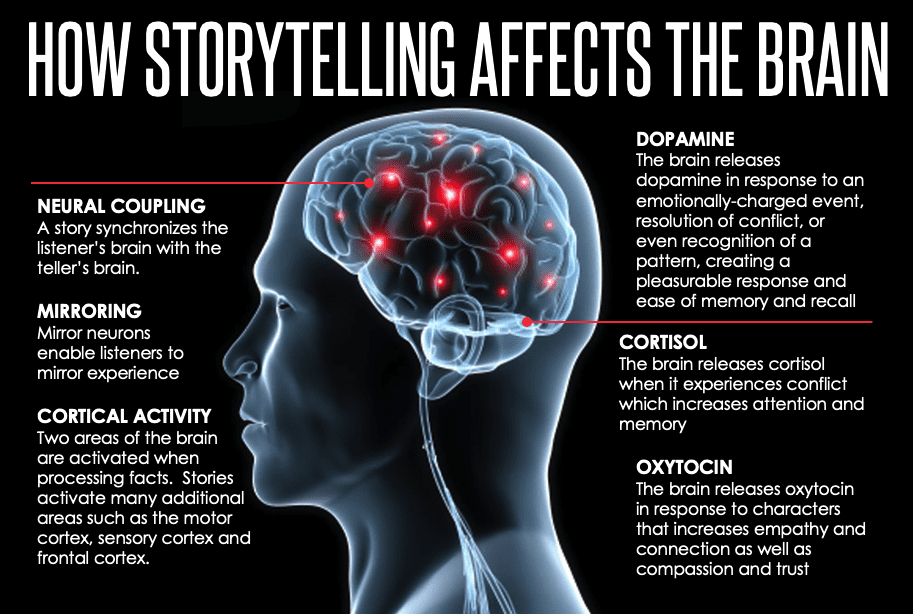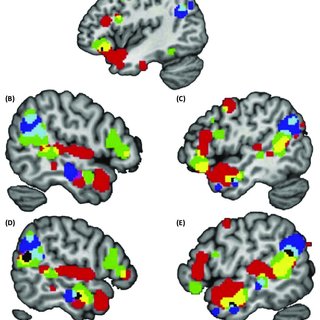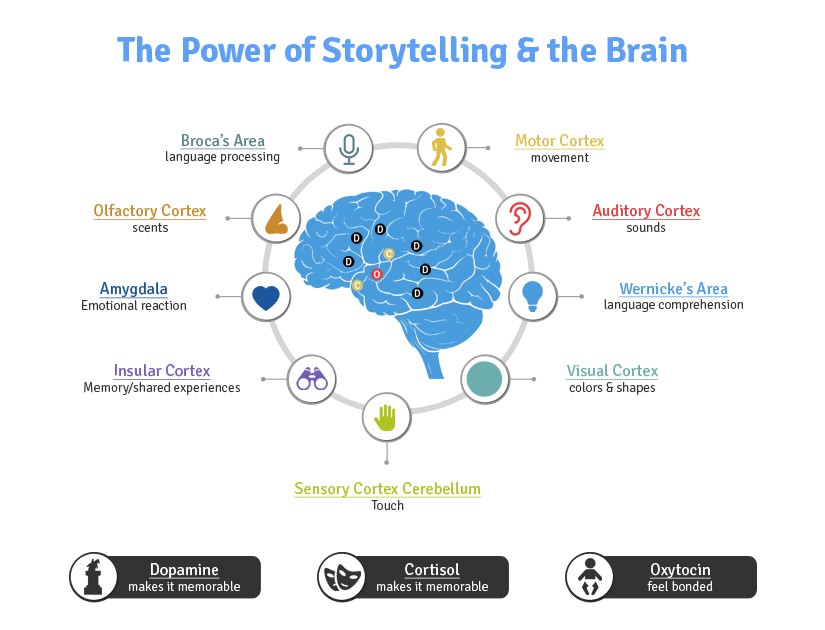2

Stories are Hardwired
“When we are being told a story, things change dramatically. Not only are the language processing parts in our brain activated, but any other area in our brain that we would use when experiencing the events of the story are too. A story can put your whole brain to work. And yet, it gets better: When we tell stories to others that have really helped us shape our thinking and way of life, we can have the same effect on them too. Evolution has wired our brains for storytelling—how to make use of it. Now all this is interesting. We know that we can activate our brains better if we listen to stories. The still unanswered question is: Why is that? Why does the format of a story, where events unfold one after the other, have such a profound impact on our learning? The simple answer is this: We are wired that way. A story, if broken down into the simplest form, is a connection of cause and effect. And that is exactly how we think.” -Leo Widrich, “The Science of Storytelling”
First, we seem “hardwired” to tell stories. Evolutionary biologists have hypothesized this idea. They propose that we humans are bombarded with so much sensory information coming into our brains via our senses (seeing, smelling, touching, tasting, feeling) that we can process only a fraction of it. The initial act of storytelling (telling a story to ourselves) enables us to “connect the dots” and makes the world and our place in it more coherent. According to Michael Gazzaniga, a neuroscientist and author of Cognitive Science: The Biology of the Mind (2014), coherence in the story we tell is more important than its truth because coherence produces a pattern and provides a structure for our experience; it gives our story a beginning, a middle, and an end. Thus, our brains assemble and “confabulate” a narrative to help us make sense of our experience. (“Confabulate” — tell a story — is a word that both Gazzaniga and another famous scientist, Edward O. Wilson, use to explain the process by which our brains transform raw sensory data into useful patterns.)
Gazzaniga explains this process in some detail in his textbook. Having made numerous studies of the brain’s right and left hemispheres, he points out the different functions of each sphere. The right hemisphere, he says, has a narrow awareness of the world and acts as a monitor, gathering information in a mostly unconscious way and storing it in millions of microscopic physical systems. The left hemisphere acts as the “Interpreter” (Gazzaniga’s term), gathering “thousands of bits of information from all over the cortex,” organizing them into a cause-effect scenario, a ”‘makes-sense’ narrative, our personal story” (620). The left hemisphere rationalizes irrational behavior, forms beliefs, and creates goals. The left hemisphere gathers information, organizes it into a coherent story within our environment, and creates the narrative of our lives. Also, according to Gazzaniga, our minds often invent events that never happened and people who don’t exist just to “hold the narrative together.”

In addition, Jason Gots, an economist and neuroscience researcher, explains in an article entitled “Your Storytelling Brain,” that storytelling is “essential to our survival” in that it enables us to “make sense of our own past experiences” and “explore possible future realities” crucial in decision-making. In other words, we imagine several future possibilities, weigh them against memories of our past experiences, and pick one that seems best. We humans confabulate; we fill gaps of memory with plausible inventions in order to preserve continuity. Evolution seems to have hard-wired our brains for storytelling because it has helped us survive. We are not stronger or faster than other species; we don’t have special sensory skills. But storytelling enables us to form memories and project future outcomes. It forms the basis for our consciousness and makes us self-aware. All this occurred, I am guessing, either shortly before Homo sapiens gained language or at approximately the same time. Perhaps our ability to tell ourselves stories was the impetus to share those stories with others.

Language Acquisition
According to an article in a 2006 Special Edition of Scientific American, “How We Came to be Human,” Ian Tattersall speculates that humans “had a vocal tract that could produce the sounds of articulate speech over half a million years before we have evidence our forebearers used language,” a phenomenon he puts at about 70,000 years ago when the earliest evidence of symbolic thought began to surface. According to Tattersall, this enabled language to spread quickly. Not all scientists agree with him on this count. According to the Smithsonian website, human language may date back to about 350,000 years ago when humans began making stone tools and coloring objects.
Spoken language became possible when the voice box dropped lower in the throat and the area above the vocal cords lengthened, which enabled us to make a wide variety of sounds. However, when that happened, it became impossible to swallow and breathe at the same time, often causing the individual to choke. Interestingly, human babies do not have a lowered voice box and can breathe while nursing like other mammal babies. In any case, sounds (perhaps imitating bird or animal sounds) and gestures probably preceded language.
Research in Neuroscience
 The brain’s wiring for stories is now becoming evident, thanks to new evidence in neuroscientific research, most recently from fMRI studies (functional Magnetic Resonance Imaging) that measure brain activity by detecting changes in blood flow and indicating neural activity as specific tasks are performed. The ability to link neural activity to the tasks of reading, listening, or viewing information and stories has produced some startling revelations. When we are presented with “information” (facts, figures, power points), only two areas of the brain, the Wernicke’s area and the Broca’s area, light up. Both areas have to do with language processing and comprehension. According to Jenny Nabben, author of The Science behind Storytelling, it is difficult for the brain to decode, process, and remember abstract or conceptual information. So, we are not inclined to remember or act on such information because it takes so much energy to decode it and because we have no emotional involvement with the information presented.
The brain’s wiring for stories is now becoming evident, thanks to new evidence in neuroscientific research, most recently from fMRI studies (functional Magnetic Resonance Imaging) that measure brain activity by detecting changes in blood flow and indicating neural activity as specific tasks are performed. The ability to link neural activity to the tasks of reading, listening, or viewing information and stories has produced some startling revelations. When we are presented with “information” (facts, figures, power points), only two areas of the brain, the Wernicke’s area and the Broca’s area, light up. Both areas have to do with language processing and comprehension. According to Jenny Nabben, author of The Science behind Storytelling, it is difficult for the brain to decode, process, and remember abstract or conceptual information. So, we are not inclined to remember or act on such information because it takes so much energy to decode it and because we have no emotional involvement with the information presented.
However, in major studies at Princeton University in 2012, Uri Hassan and his team of psychologists studied a phenomenon they call “coupling”; they found that the brain of the storyteller and the brain of the listener become inextricably linked during the storytelling experience. They discovered in fMRI studies conducted during storytelling that, whether the story is fact or fiction, multiple brain regions become activated: the motor cortex (color, shape) and auditory cortex (sound). These areas work together to build rich images that engage the emotions, and emotional associations are known to trump all other forms of mental processing. The amygdala, the integrative center for the emotions, emotional behavior, and motivation, is activated to evoke both emotional responses and past emotional memories that enable us to put ourselves in the shoes of various characters. Hassan’s research has shown that the listener experiences almost identical brain responses as the person telling the story AND the person actually having such an experience.

This is the way the storytelling experience seems to work on the part of the listener (I will use “listener” to also mean viewer, reader). Because sensory-specific words are used to tell a story, multi-sensory cortices are activated in the brain and the brain “imagines” the experience. As tension builds and the listener’s attention is sustained, emotions are neurologically activated, and the listener develops an emotional association with the character; as the story’s structure is recognized (beginning, middle, end), the listener becomes emotionally absorbed in the character’s story and begins to mimic the character’s behavior or perspective. The listener can even change his/her own behavior or perspective as a result. As an added benefit, the experience is more often than not committed to memory so that it can be recalled for future use.
Neurochemicals and Storytelling

The activation of certain areas of the brain when listening to a story depends in part on various neurochemicals. Two key components are cortisol and oxytocin. Cortisol is a chemical released when people feel distress or experience tension when a story is being told. Cortisol captures the listener’s attention long enough for the subsequent synthesis of oxytocin. In 2012 Paul J. Zak, an American economist, identified the role oxytocin plays in mediating trust between unacquainted humans. His extensive research showed that this neurochemical produces an “it’s safe to approach others” attitude toward unknown adults, motivates cooperation, enhances empathy, and makes us more sensitive to social clues.
Listening to character-driven stories produces oxytocin synthesis, a process that continues as tension in the story mounts. If this tension is sustained long enough, the listener begins to share the emotions of the character(s) and experiences empathy. The impact of the entire storytelling experience is exponential. In his article “How Stories Change the Brain,” Zak argues that stories can indeed change the brain. Once the listener’s attention is captured and oxytocin synthesis sustained, the listener begins to mimic the feelings and behaviors of the characters, an emotional involvement Zak calls “transportation.” He sees it as “an amazing neural feat” that comes from oxytocin synthesis deep within ancient parts of the brain that causes us to “simulate” emotions we intuit for the characters, emotions that we feel as well, which in turn “change the brain.”
The storytelling experience is also accompanied by the production and release of dopamine, a neurochemical responsible for reward, pleasure, goal setting, motivation, and not surprisingly, addiction. Additionally, the element of surprise in a story can become like candy to the listener; it triggers the release of adrenaline in the brain, which heightens memory formation. The best stories motivate us to make behavioral changes, engage with others, and remember the lessons for future decision-making.
Becoming Human
“Stories can be a way for humans to feel that we have control over the world. They allow people to see patterns where there is chaos, meaning where there is randomness. Humans are inclined to see narratives where there are none because it can afford meaning to our lives—a form of existential problem-solving. Stories can also inform people’s emotional lives. Storytelling, especially in novels, allows people to peek into someone’s conscience to see how other people think. This can affirm our own beliefs and perceptions, but more often, it challenges them. But why start telling stories in the first place? Their usefulness in understanding others is one reason, but another theory is that storytelling could be an evolutionary mechanism that helped keep our ancestors alive. The theory is that if I tell you a story about how to survive, you’ll be more likely to actually survive than if I just give you facts. ” -Cody Delistraty, “The Psychological Comforts of Storytelling”
We must assume that human beings have been telling stories to themselves and each other at least since we acquired language, if not before. According to Edward O. Wilson, one of the world’s leading biologists and author of The Meaning of Human Existence (2014), the “altruistic division of labor at a protected nest site” (meaning shared responsibility in a species community) has occurred in only twenty species since the beginning of life some four billion years ago: fourteen of these species are insects; three are coral-dwelling marine shrimp; and three are mammals. Of the mammals, two are African mole rats. The third is Homo sapiens. Homo sapiens had the advantages of upright walking, a large brain cavity (able to evolve the storytelling function), digital dexterity, and an audio-visual method of communication. “Of the many thousands of large terrestrial animal species that have flourished on Earth for the past four hundred million years,” Wilson explains, only Homo sapiens made the ascent. Only humans developed social units, organized political systems to manage them, and evoked great religions to guide their behavior.
The Smithsonian Institution depicts the “Homo” group on “The Human Family Tree” as consisting of seven separate species. Of these, three other species overlap with us, Homo sapiens: Homo floresiensis (the “hobbit” of Indonesia), the Denisovans, and Homo neanderthalensis. The big question is why did Homo sapiens win out while the others became extinct? Why did Homo sapiens become the one who ascended to dominate our planet? Though other factors were surely involved, the evidence is beginning to suggest that either we were the best storytelling species, or we were the only storytelling species. Storytelling may be the defining factor in the ascent of Homo sapiens and our domination of the planet Earth.
Homo sapiens’ storytelling abilities catapulted him ahead of his competitors. All four species walked upright; all four had digital dexterity, an audio-visual method of gaining information about their environment; all four had large brains. In fact, Homo sapiens’ brain was smaller than that of Homo neanderthalensis. Plus, Homo neanderthalensis was stockier, sturdier in build. And he did make tools and bury his dead. So, what gave Homo sapiens the advantage? What made Homo sapiens superior? Perhaps his brain was more nimble, more suitable for storytelling. E. O. Wilson’s vast scientific experiences indicate that “confabulation” is a human necessity: 1) it facilitates our ability to process the myriad bits of sensory information brought into our brains (research by Gazzaniga and other neuroscientists back this up), and 2) it allows us to “summon the stories of past events for context and meaning,” and use these stories to create “multiple competing scenarios” on which choices are made. In The Meaning of Human Existence, Wilson maintains, “Conscious mental life is built entirely from confabulation” (167).
Most experts put the outside limits of what we call “human behavior” at about 100,000 years ago. Most agree on sometime between 60,000 and 40,000 years ago for the emergence of symbolic thought in “story” form—the carvings of humans and animals, for example. Though experts may disagree on what “stories” these artifacts tell, all agree that “storytelling” was the aim. Communicating experience: physical, emotional, spiritual. Most agree as well that the emergence of at least some of the “humanities” occurred almost simultaneously about 50,000 years ago: Homo sapiens began painting on cave walls, making music, and ritually burying the dead (putting ornaments, flowers, weapons with the dead in the grave).
Homo sapiens came out of Africa about 60,000 years ago and literally exploded on the scene. But he was not alone. At least two other species of hominid cousins walked the Eurasian landmass—Neanderthals and Denisovans. Our ancestors encountered the Neanderthals and inbred with them and so a small amount of Neanderthal DNA was introduced into the modern human gene pool. Europeans and Asians have between 1 to 4 percent Neanderthal DNA. Indigenous sub-Saharan Africans have no Neanderthal DNA because their ancestors did not migrate through Eurasia. The Denisovans went to Siberia and Asia but were fewer in numbers and traces of Denisovan DNA have been found in modern humans. The Neanderthals died out about 30,000 years ago, only a few thousand years after modern humans arrived in Europe. Perhaps Homo sapiens’ storytelling abilities allowed him to outsmart his competitors.
See Also:
Questions
- Briefly explain, in your own words, how the human brain processes stories.
- How does storytelling play an essential role in the survival and evolution of our species?
- Give an example of how storytelling is integrated into your everyday life.
